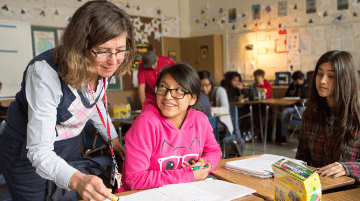Investing for Student Success: Lessons From State School Finance Reforms

Public schools in the United States are among the most inequitably funded of any in the industrialized world. Ironically, as a function of the commitment to education in each of the small towns that emerged as the country grew, the funding system that resulted is rooted in local property tax bases that are highly unequal. State funding rarely equalizes these disparities adequately. As a result, by every measure of qualifications, students in low-wealth districts, who are frequently students from low-income families, typically have the fewest resources, including less-qualified teachers, poorer curricula, larger classes, and fewer materials for learning.
Research shows that when more money is spent on education, especially for students from low-income families, achievement and graduation rates improve, as do life outcomes such as employment, and wages. Such investments also reduce poverty rates. But because of funding inequities, students in low-income districts, who are frequently from low-income families, typically have less access to essential educational resources such as qualified teachers, high-quality curricula, smaller class sizes, and high-quality materials for learning.
This report reviews resource inequalities in U.S. schools and analyzes the results of efforts to address these inequalities, examining recent research on the outcomes of school finance reforms nationally and in four states—Connecticut, Massachusetts, New Jersey, and North Carolina—where learning opportunities were substantially improved by the strategies undertaken. The report concludes with recommendations for federal and state actions that could support greater resource equity. Each of these states has taken steps to address severe funding inequities, a necessary precondition to support the kind of teaching needed for a quality 21st-century education.
All four states equalized funding across districts to provide more resources to those with greater needs. All of them also undertook a number of reforms to improve the quality of teaching, by raising salaries and standards for teacher education and licensing, investing in mentoring for beginning teachers and in high-quality professional development for veteran educators, and improving training for principals. All adopted new curriculum standards and assessments that focused on higher order thinking and performance skills and created ways to support schools and districts needing additional help to improve. Each state also invested in high-quality preschool to reduce the achievement gap before kindergarten. Their experiences demonstrate that, in the U.S., these kinds of equity-focused changes require steady work.
This report examines a critical question: How should we invest resources to achieve high-quality education in ways that redress the effects of inequities and historical discrimination? The report includes recommendations for federal and state actions that could support greater resource equity. In addition to investing in children’s basic welfare, the federal government could:
- Equalize allocations of resources available under the Every Student Succeeds Act across states so that high-poverty states receive a greater and fairer share.
- Ensure that highly qualified teachers are assigned to schools serving different populations of students.
- Require states to report and act on “opportunity indicators”—the availability of well-qualified teachers, strong curriculum, and access to adequate facilities, books, materials, and equipment—to accompany reports of academic progress for each school.
The report also provides recommendations for state funding allocations to improve schools and student learning:
- Focus funding on pupil needs and costs required to meet the state’s standards so that districts have adequate resources to hire effective educators and provide the materials needed to teach the standards.
- Develop a reliable base of funding with the flexibility to make appropriate, strategic decisions about how to spend resources based on local needs.
- Ensure high-quality preschool for children who may have fewer learning opportunities or greater learning needs before they enter school.
- Enable districts to hire and retain well-prepared educators and ensure that they have the professional knowledge and skills to teach and lead schools successfully.
As the fate of individuals and nations is increasingly interdependent, the quest for access to an equitable, empowering education for all people has become a critical issue for the nation as a whole. As a country, we must enter an era of equitable provision of high-quality education. No society can thrive in a technological, knowledge-based economy by starving large segments of its population of learning. The path to our mutual well-being is built on equal educational opportunity. And such opportunity begins with an equitable, purposeful school funding system that allows all schools to support high-quality teaching for each and every child.
Investing for Student Success: Lessons from Systemic Approaches to School Finance Reform by Linda Darling-Hammond is licensed under a Creative Commons Attribution-NonCommercial 4.0 International License.
This research was supported by the Raikes Foundation. Core operating support for the Learning Policy Institute is provided by the Sandler Foundation, the William and Flora Hewlett Foundation, and the Ford Foundation. We are grateful to them for their generous support. The ideas voiced here are those of the authors and are not to be attributed to our funders.
Photo courtesy of Allison Shelley/The Verbatim Agency for American Education: Images of Teachers and Students in Action.
Updated July 25, 2019. Revisions are noted here.
